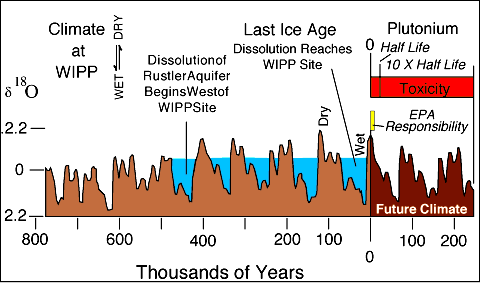
EXAMPLE 1: Mendaceous Science
The Official WIPP
"Why did EPA set the 10,000-year disposal standard?"
"There is world-wide scientific consensus that 10,000 years is a time over which we can reasonably predict geology, hydrology and climatology (we extrapolated backwards to the last ice age, 10,000 years ago). If WIPP can meet the standards for 10,000 years, then it is highly likely that it will survive beyond that. In developing the standards (40 CFR 191) for disposal of spent nuclear fuel, high-level and transuranic radioactive wastes, EPA carefully evaluated the capabilities of mined geologic repositories to isolate the wastes from the environment. Because such repositories are capable of performing so well, it was possible to choose containment requirements that will provide exceptionally good protections to current and future populations for at least 10,000 years after disposal." (http://www.epa.gov/radiation/wipp/faq.htm#store_1)
The Other WIPP
Contrary to the above statement there is no world-wide consensus that 10,000 years is long enough to assure that a site will be stable for a much longer period of time, and no credible scientist would ever make that claim. Members of a committee who were thinking mainly about hot waste with a short half-life arrived at the 10,000-year period of isolation. A rule of thumb for the safe disposal of highly toxic and long-lived plutonium is isolation for 10 times the half-life, or 240,000 years.
In the case of WIPP, the statement "... it is highly likely that it will survive beyond that" is a false one. Several studies published by geologists before WIPP was planned show that 200 hundred feet of salt has already been dissolved from the Rustler Formation above the WIPP repository. A front of dissolution is moving from west to east and over the WIPP site and most of the salt missing at WIPP was dissolved during the last glacial cycle that ended 10,000 years ago.

Studies of ice-age climate tell us that the next wet climate cycle may return within the next few thousand years and no later than about 50,000 years. When the period of EPA protection is compared to the quarter-million years needed for plutonium (see above) one can see that more active dissolution will return once again and the Rustler Aquifer will collapse and develop more fractures. The evidence at the WIPP site does not support the conclusion that the last 10,000 years of dry, stabile conditions assure an even longer period of stability.
Environmentalists were asleep at the switch when they let EPA get by with adopting 10,000 years as the isolation period. WIPP is a plutonium disposal site, the waste requires isolation for at least 240,000 years, and someone could seek an injunction against EPA on those grounds alone.
A more flagrant abuse of science is exposed by an attempt by WIPP science managers to deny the presence of dissolution above the WIPP repository. The predicament arose when the original site for WIPP was abandoned and WIPP was moved to its present location 8 miles farther to the west. Extensive dissolution at the new site meant that it was diffilcult to understand and predict the hydrology of the Rustler aquifer and to assure its long-term stability.
DOE science managers denied the existence of dissolution at the new site. In important ways this falsehood is more serious because it involves more than simple scientific error. The results of previous geologic investigations, reviewed and published long before the WIPP site was selected, demonstrated that a regional front of salt dissolution had passed over the area and removed a substantial thickness of salt from the Rustler Formation. To head off this evidence WIPP science managers asked in-house geologists to prepare a new report. The new report dismissed the previous evidence, claimed that little or no salt had been removed by dissolution, and offered the opinion that the site had been stable for millions of years. A State geologist who had conducted his own investigation of the problem was disturbed by the report's conclusions and the State hired an independent expert with superb credentials to review the defective report. The expert concluded that the original geological studies were correct. There is abundant evidence at the site for dissolution in the Rustler Formation.
DOE used the in-house report to support its claim of site stability, citing the document 14 times in the EIS. The bogus report was brought to the attention of the EPA but that agency has accepted DOE's citations and the report's conclusions. Reliance on a scientific report that is demonstrably false shows what can happen to the truth, even peer-reviewed scientific truth, when the stakes are high enough.
PREVIOUS PAGE...........NEXT PAGE